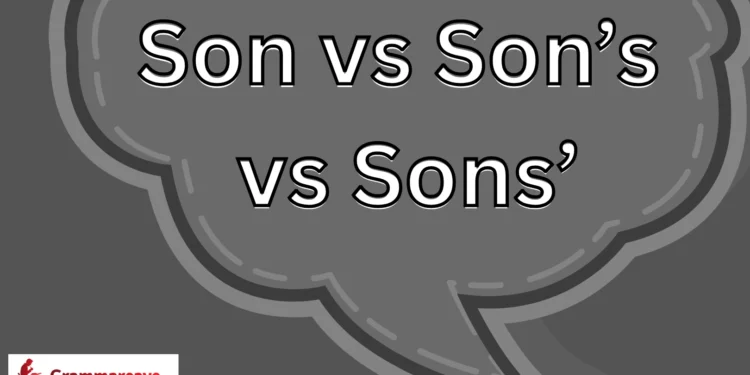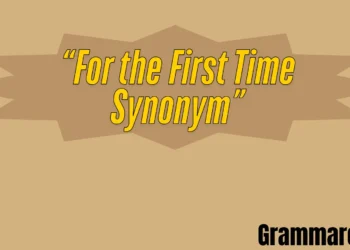As the use of son, son’s and sons’ in English sentences is different these all have an exceeding importance to facilitate you write correct and professional sounding. These three of its forms have different grammatical functions related to the word son. Possession by a single son “Son’s” Possessive shared by multiple sons “Sons’ ” Used when simply referring to more than one son without implying possessions
Learning everything on how & when to use a particular one improves your ability to express ideas precisely and boosts your grammar confidence. Either way, we will explain them with clear examples to prevent confusion and make your writing sound better. On the surface, with words similar to these two at our disposal, doing it correctly demonstrates a finesse in language and sharp communication skills.
The Singular Possessive: Son’s
The form “son’s” refers to something owned or associated with one son. It’s the singular possessive form, indicating that a single individual possesses or is connected to a particular item or action. Think of it as:
One son + ownership = son’s
Examples of “Son’s” in Action:
- My son’s toy is broken. (A toy belonging to one child)
- The son’s hat flew off in the wind. (Refers to one specific son’s hat)
- Tim’s son’s backpack was left at school. (A single son’s item is referenced)
The Plural Possessive: Sons’
The form “sons” indicates possession by more than one son. The apostrophe comes after the “s,” showing that multiple sons own or share something collectively.
Examples of “Sons” in Action:
- The sons’ jackets hung in the closet. (Multiple sons own the jackets)
- The sons’ bedroom was often messy. (A shared bedroom belonging to more than one son)
- “The sons’ school uniforms needed washing.” (Refers to clothing belonging to several sons)
The Standard Plural: Sons
The word “sons” without an apostrophe is simply the plural form. It is used when referring to more than one son, with no ownership implied.
When to Use the Plural “Sons”:
- The sons worked together to surprise their parents.
- Both sons joined us for dinner.
- The son’s siblings played in the yard.
- (Here, “son’s” refers to one son, and “siblings” includes the other children.)
Practical Applications in Daily Life
Physical Objects and Ownership
Understanding these distinctions helps in everyday situations involving tangible possessions:
- Singular example: The son’s book was on the table.
- Plural possessive: The sons’ bicycles were lined up outside.
- Shared space: The sons’ bedroom needed tidying.
Family Scenarios
Daily conversations around family life often require the correct form:
- My son’s dinner was still hot. (Only one child)
- The sons’ meal was ready by six. (Refers to multiple children)
- The family’s dinner brought everyone together. (Broader context of the entire family)
Common Mistakes and How to Avoid Them
Confusing Plural with Possessive
Plural vs. Possessive
- You’re likely already aware of this, but even the best writers sometimes make an error: unnecessary apostrophe. A word ending in “s” does not equal possessive. An apostrophe is superfluous because it is plural sons, and all you are saying is that there is more than one son.
- Wrong: Where his sons play outside.
- Correct: The sons were playing outside.
Misplacing the Apostrophe
Accurate apostrophe placement reflects your grammatical precision. Here’s a quick breakdown:
- Son’s — for a single son’s possession (apostrophe before s)
- Example: “My son’s homework is on the table.”
- Sons’ — for multiple sons sharing ownership (apostrophe after s)
- Example: “The sons’ toys were scattered across the room.”
Testing Your Understanding
Practice with Possessive Statements
Here are example sentences that apply each form:
- Singular Possession:
My son’s story about school was fascinating.
- Plural Possession:
My sons’ laughter echoed through the house.
- Simple Plural (No Possession):
The sons often play football after school.
Expert Tips for Perfect Usage
To master these forms and sharpen your writing:
- Determine the number first: Are you referring to one son or more than one?
- Assess ownership: Is the son or sons owning something?
- Place the apostrophe correctly depending on singular or plural possession.
By mastering these elements, your writing will become cleaner and more precise, making you appear professional. If you have the son’s backpack or, as in your other example, my son’s shared bedroom , correct Articulated grammar will make what you want to mean unmistakable.
Quick Reference Guide
- Son’s = something belonging to one son
- Sons’ = something belonging to multiple sons
- Sons = more than one son, with no possession implied.
Practical Applications
Proper possessive use is not simply a matter of good grammar; it also inscribes clarity and professionalism into your everyday writing. The same rule applies to even other writings you may want — personal notes, school assignments, or official documents. The hallmark of good English language and meaningful communication is that picking the correct form (for example: ‘my son’s toy’ vs my sons‘ toys’) matters!
Advanced Usage and Special Cases

Compound Possessives
Determining the correct possessive form becomes more complex when multiple individuals share ownership. Here’s how to handle compound structures involving “son’s” or “sons” in real-life scenarios:
Joint Ownership Examples
- Mom and son’s toy collection
(Indicates shared ownership between mother and one son)
- Dad and sons’ belongings
(Father and multiple sons jointly own the belongings)
- The sons’ chamber and playroom
(A shared space between brothers)
In joint ownership, only the second noun typically takes the possessive form when ownership is shared.
Professional Writing Context
Possessive structures can be critical in formal or business writing, where clarity and precision matter most. Here are examples of possessive usage in documentation:
Business Documents
- The son’s statement of inheritance: Refers to an individual son’s legal statement.
- The sons’ room assignment papers – Documents related to multiple sons’ accommodations.
- The son’s objects inventory list – A catalog of items belonging to one son.
Cultural and Regional Variations
Though the possessive rules are largely consistent, word choice and phrasing can vary slightly across regions:
British vs. American English
- UK Usage: The sons’ bedroom suite
- US Usage: The sons’ sleeping area
Both forms are correct, with differences reflecting regional preferences in vocabulary and formality, not grammatical structure.
Digital Age Applications
In social media and online communication, brevity and clarity are key. Possessive forms still matter—even in casual posts:
Social Media Examples
- My son’s plaything arrived! (Instagram post about a single child’s toy)
- The sons’ coats from @BrandName look amazing! (Twitter update about multiple sons)
- “Check out my sons jacket collection!” → Correction: “Check out my sons’ jacket collection!” (Pinterest post; apostrophe needed to show ownership)
Even informal writing benefits from proper possessive grammar, especially in public-facing content.
Real-World Scenarios
In Educational Settings
Teachers and school staff frequently use possessives when managing student belongings and communications:
- The son’s belongings were left in the classroom.
- The sons’ gym uniforms need to be washed.
- Each son’s hat must be labeled with his name.
These distinctions are key for clear communication with families and staff.
In Sports Contexts
Athletic environments often require accurate possessive usage in registration, equipment, and team references:
- “The son’s glove needs repair.” – (One child’s equipment)
- “The sons’ uniforms have arrived.” – (Team uniforms for multiple sons)
- “The sons played as a team and won the final.” – (Plural noun; no possession implied)
Practical Exercises
Test Your Knowledge
Try identifying and applying the correct form in the following real-world situations:
Single Ownership
- The son’s headwear is blue.
- My son’s accessory collection is impressive.
Multiple Ownership
- The sons’ living space needs painting.
- Their sons’ school uniforms looked identical.
Simple Plural (No Possession)
- The sons improved their language abilities.
- Both sons attended the family dinner.
Professional Applications
Professional Documentation
Correct possessive forms are essential in formal writing, especially medicine and law.
Medical Records
- The son’s medical bracelet must remain on at all times.
- Store the sons’ belongings in the pediatric ward.
- Apply sunscreen to each son’s exposed skin.
Legal Documents
- As listed in the will, the son’s property includes the family car.
- The sons’ inherited items are currently under review.
- The sons’ apartment allocations were documented last week.
Digital Age Communication
Social Media Guidelines
Adapting grammar for concise and compelling messaging is vital online.
- Caption: My son’s favorite toy just arrived!
- Story: Our sons’ matching outfits
- Bio: Proud parent of three sons building bright futures.
Professional environments call for grammatical precision:
- Endorsing my son’s speech at the seminar.
- Honoring my sons’ group exhibition.
- Captured our sons together at their graduation.
Educational Scenarios
Classroom Management
Educators frequently encounter situations that require the correct use of possessives.
Assignment Instructions
- Submit your son’s description of the object.
- Draw a diagram of the sons’ shared sleeping space.
- Write about your family’s mealtime traditions.
Parent Communications
- Your son’s backpack was found in the hallway.
- The sons’ mural project is now complete.
- Please review the upcoming family dinner schedule.
Also useful: Should you write Charles’ or Charles’s?
Cultural Considerations
International Usage
While the possessive rules remain universal, terminology and stylistic preferences may vary by region.
British English
- The son’s headwear requirements were strict.
- The sons’ chamber arrangements varied by age.
- Check the sons’ jacket regulations for boarding school.
American English
- The son’s accessory list is included.
- Update the sons’ winter coat policy.
- The sons’ clothing guidelines apply during school hours.
Modern Usage Tips
Digital Communication
Even in short-form messaging, proper grammar ensures professionalism and clarity.
- Email: Please review your son’s registration form.
- Text: The sons’ room has been cleaned.
- Social post: Here are my sons heading off to college!
Contextual Applications and Edge Cases
Special Circumstances
Hyphenated Names
Possessives with hyphenated or compound surnames follow standard rules:
- Smith-Jones’ son’s enrollment forms were submitted.
- The Brown-Wilson sons’ sports gear arrived.
- Miller-Davis’ son’s report is missing a signature.
Multiple Family Units
Careful phrasing ensures clarity in blended or extended family situations:
- The stepson’s and son’s toys were neatly arranged.
- The adopted sons’ belongings are labeled.
- The foster sons’ clothing is stored in separate bins.
Technical Writing Applications
User Manuals
Clarity in possessive structure improves user experience:
- Adjust the user’s son’s parental controls.
- Review multiple users’ sons’ profile configurations.
- Set up the family account sons’ room preferences.
Software Documentation
Precision in grammar translates to professionalism in tech fields:
- Update the user’s son’s settings under preferences.
- Access the admin’s sons’ folders securely.
- Each profile’s sons’ activity log is available under history.
Creative Writing Contexts
Proper possessives support character development and storytelling:
- The son’s journey revealed surprising truths.
- The sons’ shared legacy shaped the kingdom’s future.
- She described the sons’ personalities through vivid dialogue.
Character Development in Storytelling
Using possessive forms adds depth and clarity in narrative writing:
- The protagonist’s son’s statement shocked everyone.
- The antagonist’s sons’ clothing was tattered from battle.
- The narrator’s son’s plaything had symbolic meaning.
Dialogue Writing
Crafting realistic conversations requires attention to natural grammar:
- Is this your son’s hat?
- Where did the sons’ jackets go?
- Have you seen my sons together at the park?
Business Communications
Corporate Documentation
The proper possessive structure ensures professionalism in formal workplace communication:
HR Policies
- The employee’s son’s registration forms are due.
- Staff members’ sons’ room access must be authorized.
- Company family dinner protocols include children.
Insurance Documents
- The dependent son’s item is covered.
- Multiple sons’ belongings are listed under the policy.
- The family plan includes sons’ item coverage.
Academic Research
Citation and Methodology
Scholarly writing relies on grammatical precision for credibility:
Citation Guidelines
- The research subject’s son’s behavior was documented.
- Study participants’ sons’ attire was analyzed.
- The control group’s sons’ living arrangements were standardized.
Methodology Section
- The observer’s son’s statement was noted.
- Respondents’ sons’ belongings were cataloged.
- The sample group’s sons were interviewed together.
Modern Media Applications
Content Creation
Adapt possessive grammar for clarity across digital platforms:
Blog Writing
- A reader’s son’s object inspired the post.
- Subscribers’ sons’ experiences shaped the narrative.
- The community shared their family dinner stories.
Podcast Scripts
- In today’s episode: the host’s son’s invention.
- We’ll hear about our guest’s sons’ artwork.
- Coming up: the show’s ‘sons’ room’ feature segment.
Future Trends in Language Use
Digital Evolution
The possessive structure is evolving with technology:
- Virtual Reality: The avatar’s son’s possession was interactive.
- Augmented Reality: Holographic sons’ clothing options appeared in real-time.
- Mixed Reality: Explore the interactive sons’ shared space.
Emerging Platforms
As platforms evolve, grammar must adapt accordingly:
- Mobile Apps: Track the user’s son’s progress.
- Social Networks: View the profile’s sons’ shared albums.
- Gaming: Unlock the character’s sons in co-op mode.
Practical Tips for Mastering Possessive Forms
Memory Aids
Make grammar easier with these helpful strategies:
- Visualize arrows of ownership → Who owns what?
- Count how many owners before placing the apostrophe
- Identify if the item is jointly owned or separate
Common Pitfalls to Avoid
- Adding apostrophes to simple plurals
- Misplacing the apostrophe (before vs. after the “s”)
- Confusing shared and individual ownership
Frequently Asked Queries
Many writers encounter uncertainty regarding possessive usage involving the word son. Here are some of the most common questions clarified:
Q1. When referring to the belongings of multiple sons, is an apostrophe required?
A: Yes. Place the apostrophe after the “s” — as in sons’ — to indicate plural possession.
Q2. What should I say if I invite family for dinner?
A. For one child, ‘the son’s dinner reservation’, and multiple sons. A: the sons’ dinner reservation
Q3. Is it correct to write “sons’s”?
A. No. “Sons’s” is grammatically incorrect. Add an apostrophe after the “s”: sons for plural possessives.
Q4. Can I say “My son’s are playing outside”?
A. No. That’s incorrect. “Son’s” is singular and possessive, not plural. Use “sons” if you mean more than one child.
My sons are playing outside.
Final Thoughts
The difference between son, sons, and sons is more than a simple rule of grammar — it’s an essential skill for precision, professionalism, and clarity. Most importantly, you want your writing to sound more credible and use the right help with essay expressions that apply even when describing one son’s toy or things belonging to multiple sons.








